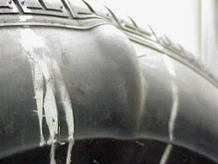Pneumatic tires are made of specialized rubber compounds reinforced by plies of fabric cords and metal wires. While most rubber compounds can be stretched easily, the underlying fabric cords and steel wires actually define the tire's shape by limiting stretching. In order to bond these dissimilar materials, the cords and wires are coated with adhesives and/or rubber before the other components are bonded to them during curing.
A strong bond between these various components is necessary to provide the desired durability. However the strength of the bond can be reduced if 1) any of the components are contaminated during manufacturing (resulting in incomplete bonding), or 2) components are damaged in service due to use while overloaded/underinflated, or by impact with potholes, curbs or other road hazards that pinch the tire between the rim and the road, or simply stretch the rubber beyond the elastic limit of the underlying cords and wires.

Past experience indicates that a sidewall separation/bubble caused by component contamination or incomplete bonding during manufacturing will appear within the first six months of service. Fortunately these separations/bubbles typically appear when they are small in size and before the tire's strength is substantially reduced. However since typical tires roll about 800 times every mile and the air pressure inside the tire is greater than outside, tire separations/bubbles that are unseen or ignored will continue to grow in size, further reduce strength, often generate noise and vibration, and ultimately lead to tire failure as the tire stretches under load (similar to the way that continuously bending a paperclip back and forth will cause it to weaken and break). However there is one last thing to remember; while a separation/bubble early in a tire's life is usually associated with a manufacturing condition, even a single, significant impact with a deep pothole or sharp curb can cause a new tire and wheel to be damaged.
If the sidewall separation/bubble appears after six months of on-vehicle service, prolonged driving on overloaded/underinflated tires or a road hazard are the most likely causes. However it may take weeks or months after an impact for a separation/bubble to appear as the damaged or bruised area continues to weaken. Unfortunately the time differential between the impact that caused the initial damage and the delayed appearance of visible evidence often means that the driver has forgotten about the impact that damaged the tire in the first place.
The varieties of possible causes make it necessary to inspect the tire while mounted on the wheel (sometimes the wheel will show impact damage adjacent to the separation/bubble), as well as to dismount the tire and inspect the condition of its innerliner thoroughly. Sometimes it is necessary to return a tire to the manufacturer's inspection center where it can be dissected before the actual cause can be determined.
While taller profile tires can be damaged by the more severe impacts with deeper potholes and sharper curbs, low profile tires mounted on large diameter wheels are the most susceptible to this type of damage. The driver of vehicles equipped with low profile tires should make special efforts to avoid potholes, curbs or other road hazards.




 DELIVERY AND INSTALLATION
DELIVERY AND INSTALLATION
